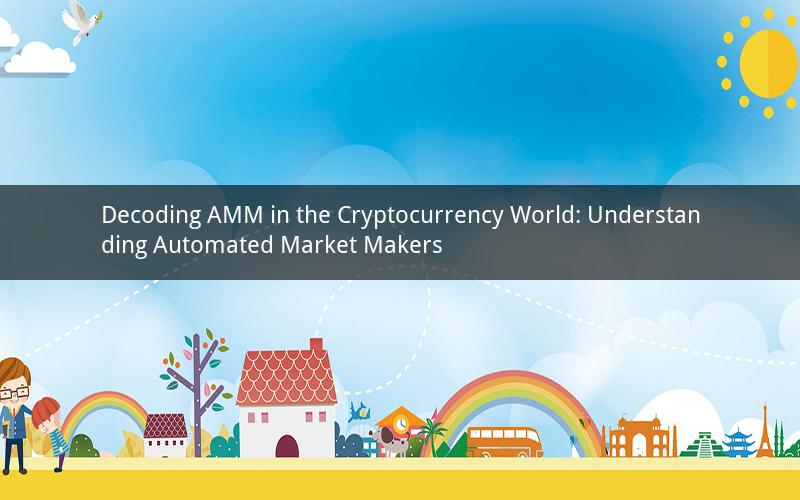
In the rapidly evolving world of cryptocurrencies, the term "AMM" has become increasingly prevalent. But what exactly is an AMM, and how does it function within the crypto ecosystem? This article delves into the intricacies of Automated Market Makers, exploring their role, mechanisms, benefits, and challenges in the cryptocurrency market.
What is AMM?
An Automated Market Maker (AMM) is a decentralized finance (DeFi) protocol that facilitates the trading of digital assets without the need for a traditional order book. Unlike traditional exchanges, where buyers and sellers submit bids and offers, an AMM uses smart contracts to create a continuous and automated marketplace for trading.
How does AMM work?
AMMs operate on the principle of liquidity pools, where traders can exchange tokens directly with the protocol. These liquidity pools are made up of a basket of tokens, and the value of each token within the pool is determined by a mathematical formula. When a trade occurs, the protocol automatically adjusts the value of tokens in the pool to maintain equilibrium.
Benefits of AMM
1. Lower transaction fees: AMMs typically charge lower fees compared to centralized exchanges, as they eliminate the need for intermediaries.
2. High liquidity: AMMs provide a constant flow of liquidity, ensuring that traders can execute trades quickly and efficiently.
3. Accessibility: AMMs are accessible to anyone with an internet connection, allowing users to trade cryptocurrencies without the need for a centralized exchange.
4. Decentralization: By removing the need for a centralized authority, AMMs contribute to the decentralization of the cryptocurrency market.
Challenges of AMM
1. Smart contract vulnerabilities: As with any blockchain-based protocol, AMMs are susceptible to smart contract vulnerabilities, which can lead to significant financial losses.
2. Slippage: Due to the automated nature of AMMs, traders may experience slippage, which is the difference between the expected price of a trade and the price at which the trade is executed.
3. Centralization risks: While AMMs aim to decentralize the market, some protocols may still face centralization risks, as a small number of liquidity providers can significantly influence the market.
4. Regulatory challenges: As the crypto market continues to grow, regulatory authorities may impose restrictions on AMMs, which could impact their operations.
Common AMM protocols
1. Uniswap: One of the most popular AMM protocols, Uniswap allows users to trade a wide range of cryptocurrencies using a liquidity pool system.
2. SushiSwap: A fork of Uniswap, SushiSwap offers similar features but also includes a governance token, allowing users to vote on protocol upgrades.
3. Curve: Curve is an AMM protocol designed for stablecoins, offering low transaction fees and high liquidity.
4. Balancer: Balancer is an AMM protocol that allows users to trade a variety of token pairs, including stablecoins, wrapped tokens, and ERC-20 tokens.
5. 1inch: 1inch is a decentralized exchange (DEX) aggregator that connects users to multiple AMM protocols, allowing them to find the best trading rates.
Frequently Asked Questions
1. What is the difference between an AMM and a traditional exchange?
An AMM operates on a decentralized, automated system, while a traditional exchange relies on a centralized authority to facilitate trades. AMMs offer lower fees and higher liquidity, but they may be more susceptible to smart contract vulnerabilities.
2. How do AMMs ensure price stability?
AMMs use mathematical formulas to adjust the value of tokens within a liquidity pool, ensuring that the price of each token remains relatively stable. However, this does not guarantee absolute price stability, as external factors can still impact the market.
3. Can I withdraw my tokens from an AMM liquidity pool?
Yes, you can withdraw your tokens from an AMM liquidity pool. However, you may incur a penalty for doing so, depending on the protocol's rules.
4. Are AMMs safe to use?
While AMMs offer numerous benefits, they are not immune to risks. Users should conduct thorough research and understand the potential vulnerabilities before engaging with an AMM protocol.
5. How do AMMs affect the overall cryptocurrency market?
AMMs have significantly impacted the cryptocurrency market by providing a decentralized, accessible, and low-cost trading platform. They have also contributed to the growth of the DeFi ecosystem, attracting both retail and institutional investors.